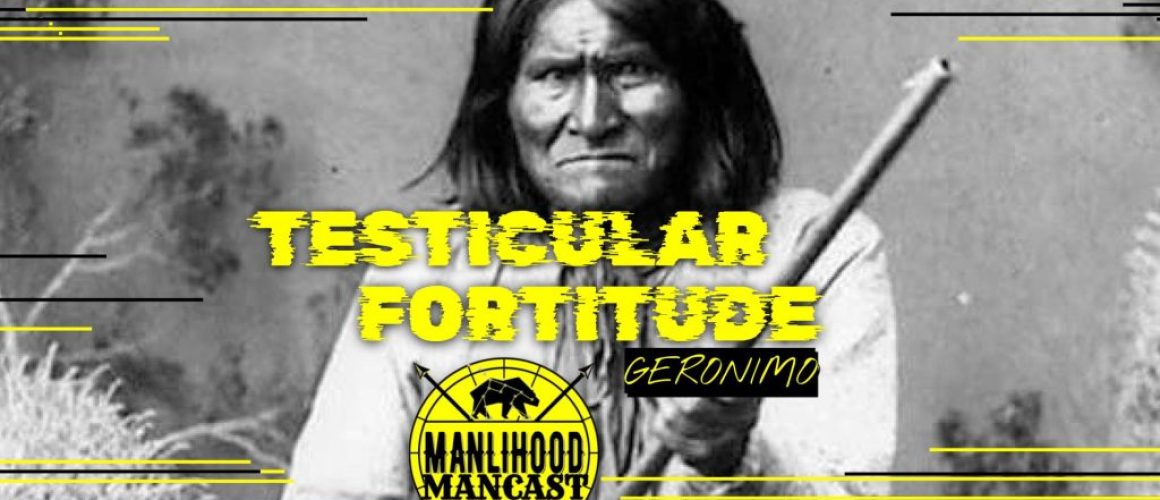Testicular Fortitude: Geronimo
This Episode is Brought To you by HAINES KNIVES
Find your new favorite knife at HainesKnives.com/mancast or follow on social media @birdforge
Testicular Fortitude means having deep seated masculine courage and strength. Balls. Guts. Manlihood.
Testicular Fortitude on the Manlihood ManCast is where we take a look at men who have beat the odds, men whose courage has left a lasting legacy.
ENTER TO WIN OUR CHRISTMAS CONTEST BY HAVEN.DESIGNED!
Testicular Fortitude
Do you have testicular fortitude? Do you want to embrace your life of courage? Join our elite group of powerhouse men who are changing the world. Manlihood.com/brotherhood
Geronimo
In World War II, paratroopers would yell “Geronimo!” as they jumped out airplanes into battle.
Growing up on Looney Tunes, I heard the shouting of that name many times over the years, and associated it with bravery and courage.
But who was Geronimo?
By all accounts in his day, he would have been seen as an outlaw. A rogue Apache on the run from the US Government. But his story is one of a man with an unquenchable fire to fight for freedom for his people.
He was born in 1829 in what would eventually become Arizona. His actual name, Goyahkla, means “one who yawns.”
He lived among the Chiricahua tribe of Apaches, and as he came of age, his people were at war with the Mexicans in the South and the US government to the North, as well as a constant war with the Comanche and Navajo.
In 1851, a group of Mexican soldiers led by Colonel Jose Maria Carrasco attacked his family camp while he was away, killing his wife, his mother, and his three children.
A voice in the wind
As was custom, he burned his family’s belongings and headed into the forest to grieve. Goyahkla said he heard a voice in the wilderness that told him, “No bullet will ever hurt you. I will guide your arrows.”
Imbued with courage from this prophecy, He declared his own war, and stalked and killed the soldiers that murdered his family.
Historians aren’t sure where the name Geronimo appeared. It could be a mispronouncing of his name, or could be associated with the sound of Mexican soldiers crying out to Saint Jerome as they were being killed by the vengeful warrior – but somehow, the name Geronimo stuck in the cultural consciousness.
Eventually, Mexico lost its war with the US, and lost claims to Arizona as well. The US Westward expansion means that the land inhabited by the natives is considered property of the United States. Tension and skirmishes arise as the US attempts to relocate the apaches. In 1872, the Chiricahua were given a reservation which included some of their original lands, but they were later relocated to live with other Apaches at the San Carlos Reservation in Arizona.
Jailbreak
Geronimo broke out of that reservation three separate times, and he would evade capture for long periods of time each time.
He believed bullets couldn’t kill him. He wasn’t afraid of the soldiers or the bounty hunters or anyone else who tried to force him to leave his homelands and live on the reservation.
His story got picked up by the sensational newspapers of the day, and he became an anti-hero – a symbol of courage as he bucked the system. Certainly some considered a villain, but even they couldn’t deny his courage and perseverance.
In 1885, a 55 year old Geronimo escaped the reservation again with 135 Apache followers, raiding Mexican and American settlements, and killing civilians for almost a year. He was forced to surrender to the US Army, but yet again, Geronimo and several of his men escaped, drawing the ire and causing the embarrassment of the US Government.
The US Army sent 5,000 troops, along with 3,000 Mexican troops to capture Geronimo and his men. Their knowledge of the hill country allowed them to evade capture for 5 months.
Surrender
In 1886, Geronimo turned himself in at Skeleton Canyon.
He was eventually imprisoned at Fort Sill at the Commanche and Kiowa reservation in what is now Oklahoma.
He spent the last 14 years of his life at Fort Sill, with occasional government approved trips to attend Wild West Shows, where he was shown off – his reputation as an unbeatable rebel, now compliant, made him quite a draw for crowds.
Geronimo and Teddy Roosevelt
Geronimo was even invited to attend the inauguration of Teddy Roosevelt. Geronimo along with several other chiefs were paraded in full headgear and war paint in attempt to show that they had “buried the hatchet forever.”
The New York Tribune tells the story of Geronimo’s meeting with Roosevelt.
“Take the ropes from our hands,” Geronimo asked the President, with tears “running down his bullet-scarred cheeks.”
Roosevelt told Geronimo that the Indian had a “bad heart.”
“You killed many of my people; you burned villages…and were not good Indians.” Roosevelt told him he would have to “wait and see” how well the Indians would “behave” on the reservation.
The meeting was quickly adjourned and Geronimo was shuffled back to the reservation in Oklahoma, where he died in 1909.
Geronimo’s fight for freedom ended in captivity and disappointment– despite converting to Christianity in an attempt to show Roosevelt that he could be a “good Indian” – he was still denied the only request he ever longed for.
His story resonated for generations… a rebel, refusing to capitulate, surviving against all odds with a heart that beat for his homeland and his people. And THAT is why Geronimo had Testicular Fortitude.




